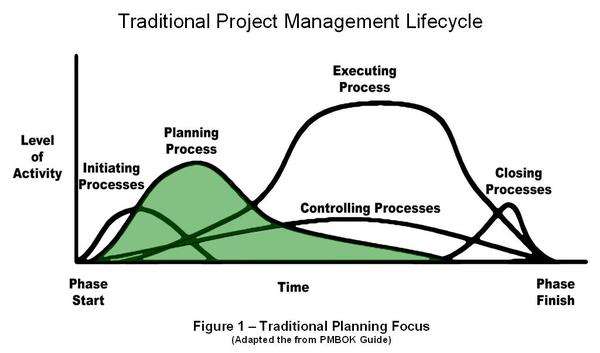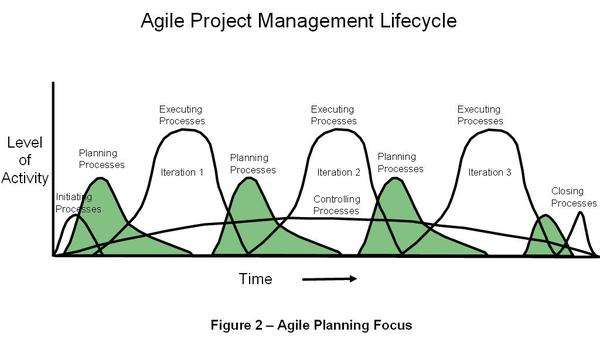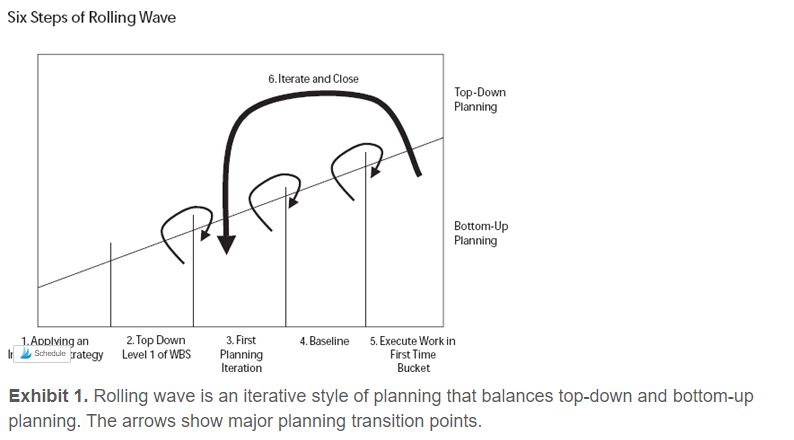The main aim of progressive elaboration is to enable a team to solicit and receive feedback from a range of stakeholders at each stage of a new project. This often leads to a modification of project requirements, and it gives the team the facts, insight, and knowledge it needs to see the project through to a successful completion.
As a Agile project manager we expect change as we are innovating and a lot of the time are dependent of user feedback to make educated decision on how best proceed. There are instance in traditional project management where there are unknowns and it makes sense to mitigate these risks by taking a rolling wave planning approach.
This way of planning can be very useful on extremely complex projects. It is a way of ensuring that people are not overwhelmed by the enormity of the tasks, and that they are able to do one thing at a time—and do each thing well.
Progressive elaboration involves continuously improving and detailing a plan as more detailed and specific information and more accurate estimates become available. Progressive elaboration allows a project management team to define work and manage it to a greater level of detail as the project evolves.
ProjectManagement.com
PMBOK 6th Edition mentions two types of progressive elaboration; rolling wave planning and prototypes.
Progressive Elaboration in Waterfall Project Lifecycle
Progressive elaboration is a process of the Project Planning Process Group set out in the Project Management Institute’s Project Management Body of Knowledge. It involves the continual improvement and development of a plan as more details about it become available.
The waterfall method is stricter. It flows from well-defined project requirements; and it is designed to move sequentially as follows: requirements-design-implementation-verification-deployment-maintenance.

The waterfall method is most suitable for projects in which the requirements are known and unlikely to change, and in which there are a great many dependent tasks and specific deployment dates. This method is easy to understand and manage. There are usually few production issues, and there is better budget management.
Change Requests as a Result of Progressive Elaboration
The employment of one of the above progressive elaboration methods may result in a change request. If the process has yielded new information, insights, and facts, the project manager may be compelled to ask for a change to the initial plan.
This can lead to more work for the project manager which is a tradeoff for mitigating the risks involved. Agile has a principle of less documentation as they embrace change.
Agile Project Management
The agile method gives teams the power to adjust the project mid-course to address customer needs or to solve problems that arise. It works best on projects without known deadlines or a full scope of requirements. It tends to require a smaller budget and is perfect for projects that are more experimental in nature.

Rolling Wave Planning and Progressive Elaboration
Rolling wave planning is a technique of progressive elaboration. It consists in planning at a very detailed level the activities that are closest to you in time, and planning in a less detailed way the operations that must be undertaken later in time.
This is one of the more flexible ways of project management. It allows your team to put their focus of effort on what is immediately before them.

Prototyping vs Iterations in Iterative process
The language of manufacturing design has made its way into the professional management industry. There is no mystery as to why this is the case. The methods required to design a product that is usable and safe can be applied to an organization that similarly wants to create an effective end-product.
The iterative process is a repeated cycle of designing, prototyping, testing, and refining multiple versions of a product. Rather than working in distinct stages, the project management team makes small adjustments to the proposed end-product in real-time. It allows the team to identify problems, get stakeholder feedback, and come up with innovative ideas as they go along. It is a more intuitive way of managing a project.
When using an iterative process, you should never have to start from scratch. You are constantly refining at every state of the process.
Benefits of Progressive Elaboration Planning
These are some of the pros and cons of using progressive elaboration:
1. Efficient Project Goal Setting
The projects most likely to succeed are those with clear and firm goals. Progressive elaboration makes it easier to set SMART goals. The acronym stands for specific, measurable, attainable, realistic, and time-bound. SMART goals will help you deliver the project on time and on budget.
2. Better communications with Progressive Elaboration
Progressive elaboration makes it easier to manage stakeholders who are critical to project success. It gives project managers the ability to build and keep their teams together. The method is also helpful in enlisting the help of organizational experts and getting feedback from frontline workers.
3. Accurate Project Risk Assessment
Progressive elaboration allows organizations to identify the biggest risks of undertaking a project before you even start it. Doing so will enable you to plan for such contingencies and make better decisions when problems emerge.
4. Avoiding Rigid Planning
There is also the risk of becoming too rigid in the execution of plans, which can create a stressful environment in the organization. The iterative process is a repeated cycle of designing, prototyping, testing, and refining multiple versions of a product. Rather than working in distinct stages, the project management team makes small adjustments to the proposed end-product in real-time
5. Identify Problems + Incorporate Feedback Earlier.
It allows the team to identify problems, get stakeholder feedback, and come up with innovative ideas as they go along. It is a more intuitive way of managing a project.
